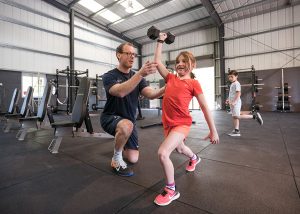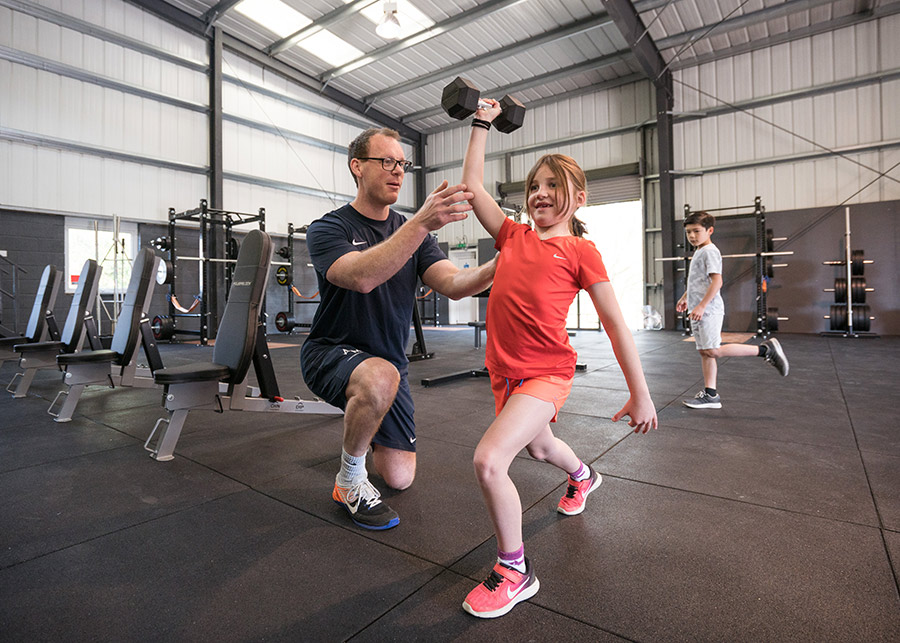Blog
Does Weight Training Stunt a Child’s Growth? What Do Experts Say?
One of the most common questions among parents today is whether weight training stunts a child’s growth or makes them shorter. In general, letting children get exposed to weights or resistance exercises early often raises concerns about their potential impact on height, bone health, or overall development. However, scientific evidence tells a very different story from these widespread beliefs. Let’s explore more in the article below!
Common misconceptions about weight training and height growth
One of the most common concerns parents have is whether weight training stunts a child’s growth or if children should even lift weights at all. This belief has existed for a long time and causes many to hesitate before allowing their kids to engage in any kind of weight or resistance training.
The misunderstanding mainly comes from the image of bodybuilders or professional weightlifters, who often have large, muscular builds but are not particularly tall. From there, many assume that lifting weights at a young age “compresses” the bones, prevents joint development, and therefore limits height growth.

In addition, many parents believe that a child’s skeletal system is still “immature,” and that lifting weights might easily cause spinal injuries, uneven bone growth, or even premature growth plate closure. However, these concerns lack scientific basis — especially as more modern studies have proven the opposite.
So, does weight training stunt a child’s growth?
This is a question that often worries parents when considering whether to let their children engage in physical training involving weights. So, does weight training stunt a child’s growth? The scientific answer is: No.
Reputable medical studies over the years have refuted the belief that weight training negatively affects children’s height growth. Specifically, the American Academy of Pediatrics (AAP) has confirmed that resistance training — including light weight training — does not damage children’s growth plates, as long as the exercises are performed with proper technique and under supervision.

A 2010 study published in the British Journal of Sports Medicine also found no evidence that proper weight training slows height growth. In fact, moderate strength training helps improve bone density and height, while supporting the healthy development of the musculoskeletal system.
Exercises involving resistance — such as dumbbells, resistance bands, or bodyweight movements — stimulate the body to naturally produce growth hormone (GH), a key factor for height development in children.
However, risks can occur if weight training is done incorrectly — such as lifting weights that are too heavy, using improper form, overtraining, not allowing time for recovery, or training without proper supervision. But when guided correctly and tailored to the child’s age and ability, weight training is completely safe and beneficial.
In summary, when practiced with proper technique, at the right age, and under supervision, weight training not only doesn’t stunt growth but actually supports height and overall physical development in children. Instead of worrying whether weight training stunts a child’s growth, parents should focus on proper education, encouraging healthy physical activity, and monitoring training progress — that’s the key to helping children reach their full potential in both height and health.

Safety Principles for Children in Weight Training
Although science has confirmed the answer to “Does weight training stunt a child’s growth?” — which is no — ensuring safety during workouts is crucial for children to gain the maximum benefits from this type of exercise. So how can children train safely, effectively, and appropriately for their age? Below are the essential principles parents should follow if they’re considering introducing their kids to weights or resistance exercises.
Do not let children lift weights unsupervised
Children have not yet fully developed body control or technical motor skills. Therefore, it’s essential to have an adult, coach, or physical education expert supervise and guide them throughout training sessions.
Younger children (ages 7–12) should begin with ultra-light weights (0.5–2 kg) or use their own body weight for resistance. Avoid using heavy barbells or complex technical movements until the child has built a solid foundation

Focus on technique, not how heavy the weight is
One main reason parents worry about “does weight training stunt a child’s growth?” is fear that heavy weights might harm the spine. Many kids and parents care too much about lifting more weight. But what truly matters is using the right form, staying safe, and controlling each move — not how heavy the weight is.
Read more:
- Do Push-Ups Stunt Height Growth? Expert Explanation
- The Average Height for USA Men – Latest Update 2025
Avoid overtraining
Kids should train with weights about 2–3 times a week, each session 20–45 minutes long.
Have at least one rest day between sessions.
Training too much doesn’t help kids grow faster — it can cause injuries and affect natural growth.
Mix weight training with other exercises
For full development, kids should also do height-friendly activities like running, jumping rope, swimming, soccer, or rock climbing.
These help improve flexibility, coordination, and support balanced growth without muscle imbalance.

Frequently Asked Questions (FAQ)
Does weight training stunt a child’s growth?
No. Many trusted scientific studies confirm that proper weight training with suitable loads and supervision does not hinder height growth.
In fact, resistance exercises can increase bone density, improve posture, and stimulate growth hormone — the key factor that supports height development.
If you want to know how to help your child grow taller, parents should explore scientifically proven height improvement methods.
At what age can children start weight training?
Children from age 7 and up can begin light weight training or bodyweight resistance exercises — without using heavy weights — and must be supervised.
The golden age for building physical foundation and promoting height growth is 6–12 years old.

Should thin or short children lift weights?
Yes — but the workout plan must be designed appropriately.
Light weight training combined with proper nutrition helps stimulate balanced muscle and bone development, supporting both height growth and overall health.
Underweight children should start with bodyweight exercises first, then gradually increase intensity as their strength improves.
How should weight training be combined with nutrition for maximum height growth?
Exercise accounts for only about 30% of growth potential; the rest depends on nutrition, sleep, and lifestyle.
To help children grow taller effectively, make sure to include:
- Calcium, vitamin D, zinc, and magnesium – to support bone lengthening and strength
- Protein – to repair muscles and promote tissue growth
- Height-supporting supplements – with clear, verified origins to ensure safety and effectiveness

How long after weight training can height growth results be seen?
Height growth is a long-term process that cannot be rushed. However, when children exercise regularly, get enough sleep (before 10 p.m.), and are supplemented with the right nutrients, noticeable improvements in height, posture, endurance, and flexibility can often be seen after about 3–6 months.
Are there any safe and natural solutions that can support children’s height growth alongside exercise?
Yes! In addition to regular physical activity, parents can combine it with natural, child-appropriate height support products. Some suitable options include Canxi Hito granules, Hito Tall tablets, or Hito Yum jelly.

The product contains key micronutrients such as nano calcium, vitamin D3, MK7, zinc, lysine, and more — helping enhance calcium absorption into the bones and supporting deep sleep, an important factor that promotes height growth.
Learn more about Hito at www.hitocalcium.us and receive a 1:1 consultation with a nutrition expert today.
